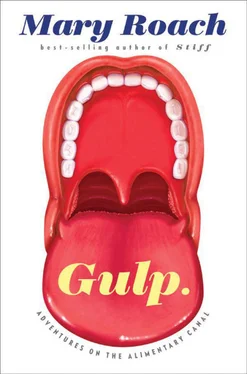Meanwhile, down the hallway, dog kibble A, dressed in a coat of newly formulated AFB palatant, is up against the competitor. The excitement is audible. One dog squeals like sneaker soles on a basketball court. Another makes a huffing sound reminiscent of a two-man timber saw. The techs are wearing heavy-duty ear protection, the kind worn on airport tarmacs.
A tech named Theresa Kleinsorge opens the door of a large kennel crate and sets down two bowls in front of a terrier mix with dark-ringed eyes. Theresa is short and brassy, with spiky magenta-dyed hair. Kleinsorge is German for “little trouble,” and it seems like a good name— trouble in the affectionate sense of well-intentioned mischief. She owns seven dogs. Amy McCarthy shares her home with six. Dog love is palpable here at PARC. It is the first pet-food test facility to “group-house” its animals. Other than during certain preference tests, when animals are crated to avoid distractions, PARC is a cageless facility. Groups of dogs, matched by energy level, spend their days roughhousing in outdoor yards.
The terrier mix is named Alabama. His tail thumps a beat on the side of the crate. “Alabama is a gobbler real bad,” Theresa says. In making their reports, the AFB techs must take into account the animals’ individual mealtime quirks. There are gulpers, circlers, tippers, snooters. If you weren’t acquainted with Alabama’s neighbor Elvis, for example, you’d think he was blasé about both foods just now set before him. Theresa gives a running commentary of Elvis’s behavior while a colleague jots notes. “Sniffing A. Sniffing B. Licking B, licking his paws. Going back to A. Looking at A. Sniffing B. Eating B.”
Most dogs are more decisive. Like Porkchop. “You’ll see. He’ll sniff both, pick one, eat it. Ready?” She puts two bowls by Porkchop’s front paws. “Sniffing A, sniffing B, eating A. See? That’s what he does.”
PARC techs also try to keep a bead on doggy interactions in the yards. “We need to know,” says McCarthy. “‘Are you down because you don’t like the food or because Pipes stole your bone earlier?’” Theresa volunteers that a dog named Rover has lately had a stomach upset, and Porkchop likes to eat the vomit. “So that’s cutting into Porkchop’s appetite.” And probably yours.
In addition to calculating how much of each food the dogs ate, PARC techs tally the first-choice percentage: the percentage of dogs who stuck their snout in the new food first. This is important to a pet-food company because with dogs, as Moeller said earlier, “if you can draw them to the bowl, they’ll eat, most of the time.” Once the eating begins, though, the dog may move to the other food and wind up consuming more of it. Since most people don’t present their dog with two choices, they don’t know the extent to which their pet’s initial, slavering, scent-driven enthusiasm may have dimmed as the meal went on.
The challenge is to find an aroma that drives dogs wild without making their owners, to use an Amy McCarthy verb, yack. “Cadaverine is a really exciting thing for dogs,” says Rawson. “Or putrescine.” But not for humans. These are odoriferous compounds given off by decomposing protein. I was surprised to learn that dogs lose interest when meat decays past a certain point. It is a myth that dogs will eat anything. “People think, Dogs love things that are old, nasty, drug around in the dirt,” Moeller told me earlier. But only to a point, he says. And for a reason. “Something that’s just starting to decay still has full nutritional value. Whereas something where the bacteria have really broken it down, it’s lost a lot of its nutritional value and they would only eat it if they had no choice.” Either way, a pet owner doesn’t want to smell it.
Some dog-food designers go too far in the other direction, tailoring the smell to be pleasing to humans [16] The Holy Grail is a pet food that not only smells unobjectionable, but also makes the pets’ feces smell unobjectionable. It’s a challenge because most things you could add to do that will get broken down in digestion and rendered ineffectual. Activated charcoal is problematic because it binds up not just smelly compounds, but nutrients too. Hill’s Pet Nutrition experimented with adding ginger. It worked well enough for a patent to have been granted, which must have been some consolation to the nine human panelists tasked with “detecting differences in intensity of the stool odor by sniffing the odor through a port.”
without taking the dog’s experience of it into account. The problem is that the average dog’s nose is about a thousand times more sensitive than the average human’s. A flavor that to you or me is reminiscent of grilling steak may be overpowering and unappealing to a dog.
Earlier in the day, I watched a test of a mint-flavored treat marketed as a tooth-cleaning aid. Chemically speaking, mint, like jalapeño, is less a flavor than an irritant. It’s an uncommon choice for a dog treat. [17] As is jalapeño—though according to psychologist Paul Rozin, Mexican dogs, unlike American dogs, enjoy a little heat. Rozin’s work suggests animals have cultural food preferences too. Rozin was not the first academic to feed ethnic cuisine to research animals. In “The Effect of a Native Mexican Diet on Learning and Reasoning in White Rats,” subjects were served chili con carne, boiled pinto beans, and black coffee. Their scores at maze-solving remained high, possibly because of an added impetus to find their way to a bathroom. In 1926, the Indian Research Fund Association compared rats who lived on chapatis and vegetables with rats fed a Western diet of tinned meat, white bread, jam, and tea. So repellent was the Western fare that the latter group preferred to eat their cage mates, three of them so completely that “little or nothing remained for post-mortem examination.”
The manufacturers are clearly courting the owners, counting on the association of mint with good oral hygiene. The competition courts the same dental hygiene association but visually: the biscuit is shaped like a toothbrush. Only Rover preferred the minty treats. Which maybe explains the vomiting.
A dog named Winston is nosing through his bowl for the occasional white chunk among the brown. Many of the dogs picked these out first. They’re like the M&M’s in trail mix. McCarthy is impressed. “That’s a really, really palatable piece in there.” One of the techs mentions that she tried some earlier, and that the white morsels are chicken. Or rather, “chickeny.”
I must have registered surprise at the disclosure, because Theresa jumps in. “If you open up a bag and it smells really good—”
The tech shrugs. “And you’re hungry…”
IN 1973 THE nutritional watchdog group Center for Science in the Public Interest (CSPI) published a booklet titled Food Scorecard , which made the claim that one-third of the canned dog food purchased in housing projects was consumed by people. Not because they’d developed a taste for it, but because they couldn’t afford a more expensive meat product. (When a reporter asked where the figure had come from, CSPI founder Michael Jacobson couldn’t recall, and to this day the organization has no idea.)
To my mind, the shocker was in the scores themselves. Thirty-six common American protein products were ranked by overall nutritional value. Points were awarded for vitamins, calcium, and trace minerals, and subtracted for added corn syrup and saturated fats. Jacobson—believing that poor people were eating significant amounts of pet food, and/or exercising his talent for publicity—included Alpo in the rankings. It scored 30 points, besting salami and pork sausage, fried chicken, shrimp, ham, sirloin steak, McDonald’s hamburgers, peanut butter, pure-beef hotdogs, Spam, bacon, and bologna.
Читать дальше












